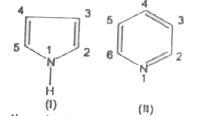Electrophilic subsitution reaction in phenol take place at :
p-position
m-position
o-poisition
o-and p-position
The correct Answer is:D
To determine where electrophilic substitution reactions occur in phenol, we need to analyze the structure of phenol and the effect of the hydroxyl (–OH) group on the aromatic ring.
1. Understanding the Structure of Phenol:
- Phenol consists of a benzene ring with a hydroxyl (–OH) group attached to it. The structure can be represented as C6H5OH.
2. Identifying Positions on the Benzene Ring:
- In the benzene ring, there are three possible positions for substitution: ortho (adjacent to the –OH group), meta (one carbon away from the –OH group), and para (opposite the –OH group).
3. Resonance and Electron Density:
- The –OH group is an electron-donating group due to its lone pairs of electrons. This increases the electron density at the ortho and para positions of the benzene ring.
- Through resonance, the lone pairs on the oxygen can delocalize into the ring, enhancing the nucleophilicity of the ortho and para positions.
4. Electrophilic Substitution:
- Electrophilic substitution reactions involve the attack of an electrophile on the aromatic ring. Since the ortho and para positions have higher electron density, they are more reactive towards electrophiles compared to the meta position.
5. Conclusion:
- Therefore, electrophilic substitution reactions in phenol primarily take place at the ortho and para positions due to the increased electron density facilitated by the –OH group.
Final Answer:
Electrophilic substitution reactions in phenol take place at the ortho and para positions.
---
- Phenol consists of a benzene ring with a hydroxyl (–OH) group attached to it. The structure can be represented as C6H5OH.
- In the benzene ring, there are three possible positions for substitution: ortho (adjacent to the –OH group), meta (one carbon away from the –OH group), and para (opposite the –OH group).
- The –OH group is an electron-donating group due to its lone pairs of electrons. This increases the electron density at the ortho and para positions of the benzene ring.
- Through resonance, the lone pairs on the oxygen can delocalize into the ring, enhancing the nucleophilicity of the ortho and para positions.
- Electrophilic substitution reactions involve the attack of an electrophile on the aromatic ring. Since the ortho and para positions have higher electron density, they are more reactive towards electrophiles compared to the meta position.
- Therefore, electrophilic substitution reactions in phenol primarily take place at the ortho and para positions due to the increased electron density facilitated by the –OH group.
Electrophilic substitution reactions in phenol take place at the ortho and para positions.
Similar Questions
Knowledge Check
Electrophilic subsitution reaction in phenol take place at :
Ap-positionBm-positionCo-positionDo-and p-positionElectrophilic substitution in phenol takes place at
Aortho positionBmeta positionCpara positionDboth (a) and ( c)Rate of substitution reaction in phenol is-
ASlower than the rate of benzeneBFaster than the rate of benzeneCEqual to the rate of benzeneDNone of these
In the following compounds

the electrophilic substitution in the ring take place at _____positions respectively
View SolutionIf aromatic ring is substitued by more than groups then electrophilic aromatic substitution reaction take place according to more activating group. Type of group which donate electron in aromatic ring known as activating group
Major product formation take placed at which position in this reaction :

View SolutionIf aromatic ring is substituted by more than groups then electrophilic aromatic substitution reaction take place according to more activating group. Types of group which donate electron in aromatic ring known as activating groups.
Major product formation take place at which position in this reaction:

View SolutionPhenol is more reactive than benzene towards electrophilic substitution reaction.
In case of Phenol, the intermediate carbocation is more resonance stabilised.
View SolutionReimer Tiemann reaction is an electrophillic substitution reaction in which the electrophile is
View Solution
